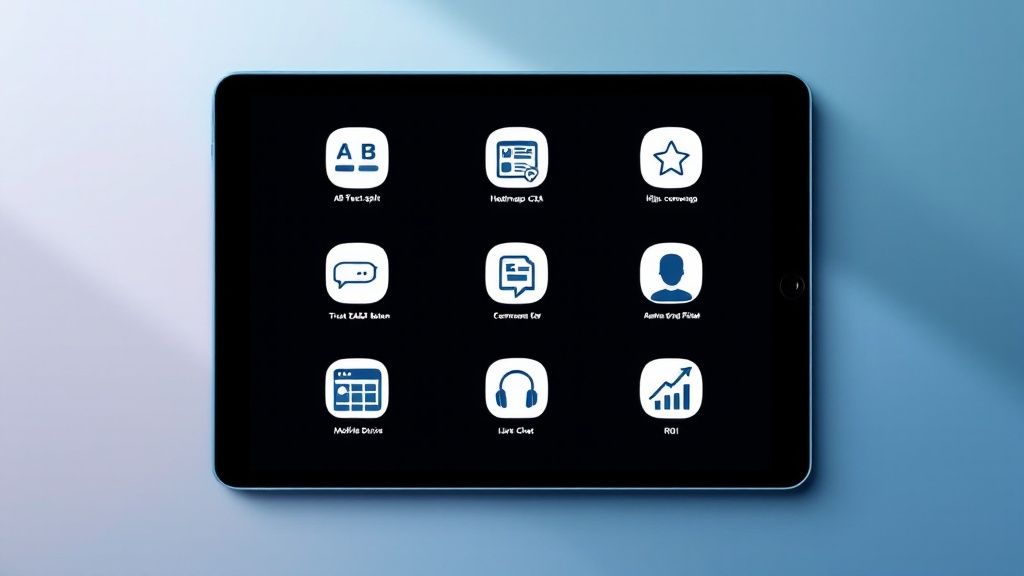
Driving traffic to your website is only half the battle. The real challenge for digital marketers and content creators is turning those visitors into loyal customers. It's a common pain point: you have solid traffic numbers, but your conversion rates remain stubbornly low, stalling growth and hurting your ROI. What if you could systematically improve your site's performance to guide more users toward taking meaningful action?
This article explores 10 essential conversion rate optimization techniques that provide actionable strategies to turn your website into a powerful conversion engine. We'll cover everything from data-driven A/B testing and landing page optimization to enhancing social proof and streamlining your checkout process. These are practical steps you can implement today to see measurable results and maximize the value of every visitor.
1. A/B Testing (Split Testing)
A/B testing, or split testing, is a foundational method among conversion rate optimization techniques. It involves creating two versions of a web page or digital asset (like an ad) and showing them to different segments of your audience. By measuring which version drives more conversions, you can make data-driven decisions instead of relying on guesswork. This scientific approach removes subjectivity, ensuring that changes to your site are statistically proven to improve performance. For a marketing agency, this means you can confidently show clients why a new headline or button color is driving more leads.
How to Implement A/B Testing Effectively
The core of A/B testing is isolating variables. For instance, to test a call-to-action button, you might create "Variation A" with the original text and "Variation B" with new, more compelling text, keeping all other elements identical. Tools like Optimizely or VWO split your traffic, showing each variation to a segment of your audience. The platform then tracks which version achieves a higher conversion rate with statistical significance. A famous example is when the 2008 Obama campaign increased donation conversions by over 40% just by testing different button text and hero images.
Actionable Tips for Successful Split Tests:
- Test One Variable at a Time: Isolate single elements like a headline or button color to know what caused the change.
- Ensure Sufficient Sample Size: Run tests long enough to gather enough data for a statistically significant result (typically at a 95% confidence level).
- Focus on High-Impact Pages: Start with pages crucial to your bottom line, such as pricing pages, landing pages, or the homepage.
- Document Everything: Keep a log of your hypotheses, variations, and results to build a library of learnings for future campaigns.
2. Landing Page Optimization
Landing page optimization is the process of enhancing a standalone web page created for a specific marketing or advertising campaign. Its goal is to increase the percentage of visitors who complete a desired action, such as signing up for a free trial or downloading a resource. This involves refining every element—from headlines and copy to forms and layout—to create a focused experience that guides users directly toward the conversion goal. For a startup launching a new product, an optimized landing page is crucial for converting ad spend into qualified leads.

How to Implement Landing Page Optimization Effectively
The key principle is creating a seamless, distraction-free journey from ad click to conversion. Every element must support a single, clear objective. This is achieved by ensuring message match between the ad and the page, using compelling visuals, and presenting a strong value proposition. Tools like Unbounce or Leadpages simplify creating and testing these dedicated pages. For example, Shopify famously increased trial signups by reducing the number of form fields, lowering friction for potential users and making the conversion process smoother.
Actionable Tips for Successful Landing Pages:
- Match Ad Copy to Page Content: Ensure the headline on your landing page perfectly aligns with the ad that brought the visitor there.
- Minimize Distractions: Remove main navigation and other outbound links to keep the user focused on the single call-to-action.
- Include Trust Signals: Use testimonials, customer logos, and security badges to build credibility and reduce visitor anxiety.
- Optimize Your Forms: Keep forms as short as possible. Only ask for information you absolutely need.
3. Personalization and Dynamic Content
Personalization is one of the most powerful conversion rate optimization techniques, delivering experiences tailored to individual users. This strategy uses visitor data—such as behavior, demographics, and location—to dynamically alter website content, offers, and recommendations. By showing users content that is highly relevant to their needs, you can dramatically increase engagement and guide them more effectively toward conversion. For an e-commerce brand, this could mean showing a returning visitor products related to their last purchase, instantly making their experience more relevant.

How to Implement Personalization Effectively
Implementing personalization involves leveraging data to create customized user journeys. For example, a B2B site can display case studies relevant to a visitor's industry, making the content more impactful. Tools like Dynamic Yield or Adobe Target analyze user data in real-time to serve this dynamic content. This technique is famously used by Amazon, whose recommendation engine is reportedly responsible for a significant portion of its revenue by suggesting products based on browsing history and past purchases.
Actionable Tips for Successful Personalization:
- Start with Segmentation: Group your audience based on simple criteria like new vs. returning visitors, traffic source, or location.
- Use Progressive Profiling: Gradually collect user information through interactions rather than asking for everything at once.
- Personalize Calls-to-Action (CTAs): Tailor CTAs based on a user's stage in the buyer's journey. A first-time visitor might see "Learn More," while a repeat visitor sees "Buy Now."
- Leverage Location-Based Content: Display store-specific offers or relevant local content for businesses with a physical presence.
4. Social Proof and Trust Signals
Social proof is a psychological principle where people follow the actions of others, assuming those actions reflect the correct behavior. As one of the most effective conversion rate optimization techniques, it involves strategically displaying evidence that others have chosen and are happy with your product. This reduces visitor anxiety and builds the confidence needed to make a decision. For a freelancer or small agency, showcasing client testimonials can be the deciding factor for a potential customer who is on the fence.
How to Implement Social Proof and Trust Signals Effectively
Integrating social proof means showcasing credibility through customer testimonials, reviews, and security badges. Basecamp famously increased signups by over 100% just by adding authentic customer testimonials to their landing page. Similarly, websites like Booking.com use real-time notifications like "2 people are looking at this right now" to create urgency and popularity. To build credibility, incorporating strong social proof is key. For example, explore how to influence B2B buyers with impactful case studies to demonstrate your product's value.
Actionable Tips for Successful Social Proof:
- Place Testimonials Strategically: Position reviews near key conversion points like "Add to Cart" buttons.
- Prioritize Specificity: Use detailed reviews that highlight specific benefits rather than generic praise.
- Showcase Security Badges: Display trust seals from McAfee or Norton prominently on payment and checkout pages.
- Use Real Numbers: Highlight metrics like "10,000+ customers served" or "trusted by teams at Google & Slack."
- Leverage Video Testimonials: Videos add a layer of authenticity and are often more persuasive than text.
5. Call-to-Action (CTA) Optimization
A call-to-action (CTA) is the button or link that prompts users to take a specific action. CTA optimization is one of the most impactful conversion rate optimization techniques because it directly targets the final step a user takes before converting. This involves refining the CTA's copy, color, size, and placement to make it as compelling and clear as possible. For a content creator, an optimized CTA can be the difference between gaining a new subscriber and a visitor simply clicking away.
How to Implement CTA Optimization Effectively
Effective CTA optimization hinges on psychology and clarity. Your goal is to remove friction and create a powerful incentive to click. Instead of generic words like "Submit," use action-oriented, value-driven text. HubSpot famously increased clicks by changing a button from "Submit" to "Get My Free Ebook," reinforcing the value. Similarly, Performable (now part of HubSpot) boosted conversions by 24% by changing its CTA from "Start your free trial" to the more specific "Start your free 30-day trial."
Actionable Tips for Successful CTA Optimization:
- Use Action-Oriented, First-Person Copy: Phrases like "Get My Free Quote" often outperform "Get Your Free Quote." Improve your CTAs with our guide on copywriting tips for beginners.
- Create Urgency: Use time-sensitive language like "Shop the Sale Now" or "Limited Seats Available."
- Leverage Contrasting Colors: Your CTA button should stand out from the page's color scheme.
- Optimize Placement: Position CTAs where users naturally pause, such as above the fold and after key value propositions.
👉 Try MediaWorkbench.ai for free – schedule your posts and generate AI content in one place!
6. Form Optimization
Web forms are the final gatekeepers to conversion, yet they are often a major source of friction. Form optimization is the process of improving web forms to make them easier and more intuitive to complete. By refining elements like length, field types, and layout, you can significantly reduce user frustration and increase submission rates. This is a critical conversion rate optimization technique because even minor improvements can yield substantial gains in leads or sales for any digital marketer.
How to Implement Form Optimization Effectively
The core principle is to minimize user effort. Question the necessity of every single field. Platforms like Typeform and Formstack encourage simpler, more engaging form experiences. For example, a multi-step form can break a long process into manageable chunks, reducing cognitive load. A famous case study involves Expedia, which increased its annual profit by $12 million simply by removing one optional field ("Company") from its booking form, demonstrating the immense impact of reducing friction.
Actionable Tips for Successful Form Optimization:
- Ask for Only Essential Information: Every extra field is a potential drop-off point.
- Use Single-Column Layouts: A single, vertical column is easier for users to scan, especially on mobile.
- Provide Clear Error Messages: Use inline validation to instantly flag errors and explain how to fix them.
- Show Progress Indicators: For multi-step forms, a progress bar helps manage user expectations.
- Use Appropriate Input Types: Leverage modern HTML5 input types (e.g.,
tel,email) to bring up the correct keyboard on mobile devices.
7. Page Speed and Performance Optimization
In the world of conversion rate optimization techniques, speed is non-negotiable. Page speed optimization is the process of making your website load faster. In an era of instant gratification, even a one-second delay can lead to increased bounce rates and lost revenue. A slow site creates a poor user experience, directly impacting your bottom line and search engine rankings. This is a crucial consideration for any business, as a fast, responsive site builds trust and keeps users engaged.

How to Implement Page Speed Optimization Effectively
Improving site performance involves technical adjustments to reduce load times. Start by auditing your site using tools like Google PageSpeed Insights or GTmetrix to identify bottlenecks like large images or slow server response times. The impact is well-documented: Walmart saw a 2% conversion rate increase for every one-second improvement in load time. Similarly, AliExpress boosted its conversion rates by over 10% after reducing its page load time by 36%, proving that technical performance is a powerful revenue driver.
Actionable Tips for Faster Load Times:
- Compress Images: Use tools to reduce image file sizes without sacrificing quality.
- Minimize HTTP Requests: Reduce the number of scripts, images, and CSS files a browser has to load.
- Leverage Browser Caching: Store static resources in a user's browser so they don't need to be reloaded on subsequent visits.
- Use a Content Delivery Network (CDN): Distribute your content across multiple servers globally to deliver it faster. You can learn how to measure the impact of these changes on domain.com.
8. Mobile Optimization and Responsive Design
With mobile traffic dominating desktop, mobile optimization is a critical component of any conversion rate optimization strategy. This involves designing a website that provides a seamless, user-friendly experience on smaller screens. A responsive design automatically adapts your site's layout to the user's device, ensuring that navigation, content, and CTAs are clear and accessible. For marketers and creators, a poor mobile experience means losing a significant portion of your audience before they even have a chance to convert.
How to Implement Mobile Optimization Effectively
The core philosophy is "mobile-first," which prioritizes designing for the smallest screen and then scaling up. This ensures the mobile experience is not an afterthought. By focusing on touch-friendly interfaces, fast load times, and simplified navigation, you remove friction from the mobile user journey. For example, retailer ASOS improved its mobile conversion rate by 50% by creating a streamlined, mobile-centric checkout process, demonstrating how focusing on the specific needs of mobile users is a powerful conversion lever.
Actionable Tips for Successful Mobile Optimization:
- Design for Thumbs: Place key interactive elements within easy reach of a user's thumb.
- Simplify Forms: Reduce the number of form fields and use mobile-friendly inputs.
- Optimize for Speed: Compress images and leverage caching to ensure your site loads quickly on mobile connections.
- Implement Mobile-Specific Payments: Integrate one-click payment options like Apple Pay and Google Pay to reduce checkout friction.
Conclusion
Mastering conversion rate optimization is a journey of continuous improvement, not a one-time fix. By implementing these proven techniques—from data-driven A/B testing and seamless landing page experiences to building trust with social proof—you can transform your website from a digital brochure into a powerful conversion engine. The key is to adopt an experimental mindset, always prioritizing the user experience and letting data guide your decisions. By focusing on removing friction and clarifying your value at every touchpoint, you create a path that naturally leads visitors toward becoming loyal customers.
Ready to put these strategies into action and streamline your content workflow? MediaWorkbench.ai helps you generate optimized copy, schedule social media posts, and manage your entire content strategy in one place.
Start your free trial of Media Workbench AI today and see the difference!

